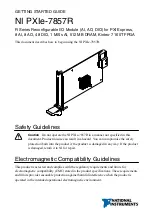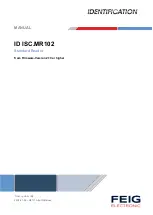
Chapter 1. Introduction
14
PACSystems* RX7i & RX3i TCP/IP Ethernet Communications User Manual
GFK-2224Q
communicating to a redundant system. Existing SRTP Server connections at the direct IP address are not
disturbed when the Ethernet interface switches between active and backup states.
SRTP Client Operation in a Redundancy System
Only the active unit establishes and maintains SRTP Client connections (channels). The backup unit does not
initiate any SRTP Client operations. If SRTP Client operations are attempted, a COMMREQ error status is returned
to the local logic program. When the Ethernet interface changes from active to backup state, it takes down all
SRTP Client connections and their underlying TCP connections.
Because it can take some time to take down a TCP connection, the redundant system should reserve a spare
SRTP Client connection for each connection using the Redundant IP address. That will prevent temporary
resource problems when establishing new SRTP Client connections to the new active unit while the previous
connections to the old active unit are being taken down.
Modbus TCP Server Operation in a Redundancy System
Only the active unit maintains Modbus TCP Server connections
at the Redundant IP address
and is able to
respond to Modbus TCP requests. The backup unit does not respond to the Redundant IP address. When an
Ethernet interface changes from active to backup state, it takes down all Modbus TCP Server connections and
their underlying TCP connections that use the Redundant IP address.
Remote hosts should use the Redundant IP address when communicating to a redundant system. Existing
Modbus TCP Server connections at the direct IP address are not disturbed when the Ethernet interface switches
between active and backup states.
Modbus TCP Client Operation in a Redundancy System
Only the active unit establishes and maintains Modbus TCP Client connections (channels). The backup unit does
not initiate any Modbus TCP Client operations. If Modbus TCP Client operations are attempted, a COMMREQ error
status is returned to the local logic program. When the Ethernet interface changes from active to backup state,
it takes down all Modbus TCP Client connections and their underlying TCP connections.
Because it can take some time to take down a TCP connection, the redundant system should reserve a spare
Modbus TCP Client connection for each connection using the Redundant IP address. That will prevent temporary
resource problems when establishing new Modbus TCP Client connections to the new active unit while the
previous connections to the old active unit are being taken down.
EGD Class 1 (Production & Consumption) in a Redundancy System
The active unit produces Ethernet Global Data exchanges to the network. The backup unit produces only the
EGD exchanges for which Produce in Backup Mode is enabled. When the active Ethernet interfaces changes to
backup, it stops production of all EGD exchanges.
When configured for Redundant IP operation, the active and backup Ethernet interfaces should be configured to
consume EGD exchanges via multicast host groups or the local subnet broadcast address. This permits both the
active and backup units to receive the latest data from the network. Unicast operation is not recommended. The
backup unit does not consume any unicast exchanges at the Redundant IP address.
EGD Class 2 Commands in a Redundancy System
Remote hosts should use the Redundant IP address when communicating to a redundant system. Only the
active unit responds to EGD commands. The backup unit does not respond to the Redundant IP address. When
the active Ethernet interface changes to backup, any EGD command currently in process over the Redundant IP
address is ended.
When configured for Redundant IP operation, only the active unit sends EGD commands on the network. If the
backup unit tries to initiate any EGD commands, a COMMREQ error status is returned to its application program.
When the active Ethernet interfaces changes to backup, any EGD commands in process are ended.
Although not recommend, EGD commands may be issued to the direct IP address. Both the active and backup
units will respond to EGD commands received at the direct IP address.
Summary of Contents for PACSystems RX7i
Page 45: ......
Page 80: ...Chapter 4 Configuration GFK 2224Q January 2017 67 ...
Page 81: ......
Page 122: ...Chapter 6 Programming EGD Commands GFK 2224Q January 2017 109 ...
Page 147: ......
Page 211: ......
Page 262: ...Chapter 13 Network Administration GFK 2224Q January 2017 249 ...
Page 263: ......
















































